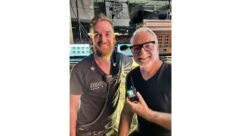Covering the full spectrum
Nov 1, 2000 12:00 PM,
Andy Ciddor
At Sydney’s SuperDome arena, the sound-reinforcement system needed to provide intelligibility while accommodating a diverse range of applications.
Sydney’s new SuperDome arena is located in the heart of the Homebush Olympic Park precinct at Olympic ground zero. Since opening in September 1999, it has hosted events as diverse as the Superstars of Wrestling, Alanis Morrisette and Garbage, Moto-Cross, Luciano Pavarotti, the Monster Trucks Show, professional basketball and numerous banquets, luncheons, tradeshows and exhibitions. During the Sydney 2000 Olympics, it was the venue for the basketball finals and the artistic gymnastics and trampoline. For the Para-lympics that follow, it will be the site for the wheelchair basketball. Its first Olympic role, however, was as the venue for the official opening of the Olympic Arts Festival when 1,000 musicians gave a rousing performance of Mahler’s Eighth Symphony.
Built at a cost of A$200 million, this striking, award-winning structure of concrete, steel and glass uses an innovative mast-and-truss roof suspension system to give uninterrupted views for all 21,000 seats. The brief for the public address system called for spoken-word intelligibility of more than 95% at 105 dB SPL over the entire seating area. This stringent specification is necessary to deal with a broad spectrum of events, which in the case of Moto-Cross, may have up to 15 motorcycles roaring around on an indoor dirt track. The system also requires the capability to handle the dynamic range required for music replay at such events as the Olympic gymnastics and the professional basketball matches, which are frequent bookings at the SuperDome.
A team from Philips Projects Division, led by design engineer Patrick Cunniffe, won the contract for the public address system on the basis of its design’s ability to meet the demanding specification from project acoustician Robert Fitzell. Cunniffe’s original concept was for the PA loudspeakers to be grouped in traditional clusters for directionality and bass response, but he eventually chose a distributed array because of the higher inherent intelligibility. This approach impressed Fitzell, who viewed intelligibility as the key system criterion. The same Philips group has also recently provided PA systems for the Parramatta Football Stadium and the Bruce Stadium in Canberra, which is a venue for the Olympic football competition.
Cunniffe used ADA Acoustic Design Ahnert’s EASE simulation software to design the SuperDome system, as Philips does on almost every project. According to Cunniffe, the EASE database is extensive, and he has found that most loudspeaker manufacturers have data in EASE format available for their products.
“We used Renkus-Heinz equipment in this situation purely and simply because the SuperDome specification required high standards of intelligibility,” Cunniffe said.
For the ceiling and the walls at the rear of the seating, Fitzell specified a perforated corrugated metal sheeting backed by acoustically absorbent fiber, a strategy that successfully reduced the reverberation time of the empty building to a respectable 2.6 seconds. Because the loudspeakers in the SuperDome are located approximately 75 feet (23 m) above floor level, the requirement to achieve a hefty 105 dB SPL in the seating areas means a loudspeaker output of around 135 dB at 1 m.
Renkus-Heinz TRAP40/6K three-way, biamplified speakers, with their 60øx40ø pattern, were selected for their wide pattern bandwidth (frequency range over which actual dispersion varies less than ñ5ø from nominal) and high output. At each point in the array, which is suspended 23 feet (7 m) below the roof catwalks, there is a pair of TRAP40/6Ks – one directed downward for the lower tier seats and the other angled at 40ø to cover the middle tier. Suspended from the next catwalk out are a row of Philips SR series LHM 0235/00 loudspeakers that supply high frequency fill for the top tiers of seats. A further ring of the LHM 0235/00 boxes are suspended on the outer catwalk ring, directly above the top half-dozen rows of seats, to overcome the loss of intelligibility caused by reflections from the rear walls.
To supply sound to the performing and playing area, four RH TRAP40/9K (the 90ø version of these three-way loudspeakers) were suspended under the variable-height gondola that carries high resolution video screens and scoreboards. Loudspeaker controllers and amps for the TRAP40/9Ks are located in a rack inside the gondola. The “K,” incidentally, refers to a new, higher-performance compression driver that Renkus-Heinz has introduced in many of its loudspeakers. There are no additional bass or sub-bass devices in the PA system, which rolls off at around 50 Hz to avoid the boominess inherent in the building’s acoustics.
Time alignment for the system was initially simple with a central point of origin that required delays to only the two outer rings of LHM 02325/00 boxes. The requirement was, however, expanded to include the possibility of the sound originating from an end-stage, which could be located at either end of the floor, thereby creating a need for 16 delay zones. All time alignment is achieved by the delay cards in the system’s two Allen & Heath DR128 24-bit mix-processors. These 12-input, eight-output devices implement all EQ, compression and limiting, mixing, routing and level control in the system. They are also used to provide ducking for the emergency warning and evacuation system. The DR128s are located in the main equipment racks on the catwalk level and are remote operated from the control room desktop computer via an RS-232/RS-422 serial data line.
To simplify sound operations for venue hirers, three push-buttons have been installed in the control room which reset the DR128s to the basic settings for a central source, or either one of the end-stages. Because Philips also provided the PA system for the SuperDome’s foyer and circulation spaces, the feeds to these areas are delayed through the DR128 to provide a seamless transition from foyer to auditorium.
The mixing desk is a 24-channel Allen & Heath GL2200 configured for mono output. Mics used in the system are beyerdynamic radio mics – SDM 400 handhelds and TSP 400 lavaliers in conjunction with NE 400 diversity receivers connected to catwalk-mounted aerials. Replay facilities for the system are a Marantz PMD 350 dual-function cassette/CD deck, a Marantz ST-48 tuner and a Tascam DA-20 MkII DAT player.
The Renkus-Heinz R-Control system is used throughout the venue to monitor and control amp performance and operations. The control room desktop computer is fitted with an R-Control interface card, which connects to the R-Control-enabled Renkus-Heinz P3501E and P2400E amps throughout the PA system via twisted-pair wiring. The data network loops from the control room through each of the amps in the four catwalk-mounted equipment racks, via the rack in the scoreboard gondola and back to the control room. This ring topology, one of many possible with the Echelon networking protocol used in R-Control, allows data to circulate in either direction around the ring, thus providing redundant data paths to and from all amps, even in the event of a cable failure.
R-Control gives the PA operator remote control over such key functions as AC power on/off, input mute/unmute, channel levels and channel polarity. The computer screen displays input and output signal level meters, limit and clipping indicators and real-time impedance values for each amp. For simplicity of operation, the amps powering each delay ring can be controlled as a group.
The RH TRAP 40K loudspeakers are powered by 750 W per channel Renkus-Heinz P3501E amps. These are driven by either Renkus-Heinz single-channel X12 or dual-channel X24, Loudspeaker Specific Processors fitted with TRAP40K Loudspeaker Specific Parameter modules. Each amp is configured to provide the pair of feeds for two TRAP40K biamplified speakers. The first RH P3501E amp, driven by each X12 or X24, is also connected to the processor’s sense lines. This means that the limiters are looking at actual amp output and cannot be fooled by accidentally adjusting the input gain, an additional level of automated loudspeaker protection. Additionally, the Philips LHM0235/00 loudspeakers are powered by Renkus-Heinz P2400E, 350 W per channel amps with a pair of loudspeakers on each channel.
In commissioning tests, the Philips team, wearing ear protection, drove the system to the point where all outputs showed red lights, but the automated limiting in both the DR128 system processors and the X12 and X24 loudspeaker controllers prevented the system from going into distortion, even at the specified maximum 105 dB level. Since the SuperDome opened, the PA, together with all A-V systems, has been operated under contract by Frank Madzin and his team from Madzin Productions.
Although built as part of Sydney’s frenzy of pre-Olympic construction, the Super-Dome is a flexible, multi-purpose venue which will serve Sydney audiences in a wide variety of roles long after the hoopla dies down and the last Olympic tourist has packed away that souvenir Koala Bear doll.
When Renkus-Heinz began designing integrated loudspeaker systems in the 1970s, the idea was a radical departure; sound-reinforcement professionals bought raw frame drivers and horns, cut wood, wound crossover coils, had custom hardware made and built their own loudspeakers. Today, the packaged loudspeaker with transducers, horns, passive internal filters, external active electronics, enclosure and hardware designed as a system is the industry standard. The success of these products demonstrates that systems engineering can deliver higher levels of efficiency, accuracy, reliability and output. Some manufacturers, including Renkus-Heinz, are expanding the loudspeaker system to include power amplification.
Although many single loudspeakers can sound natural and true to the source material, arrays or tight-packed clusters are still frequently disappointing, even with trapezoidal arrayable enclosures. Problems include lobing and comb filtering that cause inconsistent frequency response across the horizontal coverage area of the array, sometimes accompanied by excessive low frequency spill onto the stage or the podium.
Renkus-Heinz Engineering addressed these problems by treating the entire cluster as an integrated system, using the full range of design tools and dealing with the signal chain from line level to listener. The concept of an integrated system that includes multiple loudspeakers (a reference point array or RPA) includes such mechanical issues as enclosure topology and hardware. RPAs use defined signal flow to incorporate crossovers, equalization, delay and limiting with parameters adjusted for each element in the array.
The design processIn designing a packaged loudspeaker system, engineers measure components as part of the selection process. Transducers might be selected based on sensitivity, power handling, distortion and frequency response over the desired bandwidth. The loudspeaker will be assembled from the best available choices, none of which will be completely perfect. The entire package will be measured on axis, and polar response plots will also be generated. Signal processing will be applied to minimize such problems as out-of-phase output in the crossover region between a cone woofer and a compression driver/horn. This is possible because the physical relationship between the voice coils of the two transducers is defined by the enclosure. At this point, the packaged loudspeaker designer is done; when engineers cannot predict how loudspeakers will be packed together in clusters or how many will be used, they can proceed no further. Having optimized a single loudspeaker in the test facility, the engineer is forced to release it into the random, uncontrolled conditions of the real world of sound reinforcement. The results will be as unpredictable as the conditions of use.
The RPA design process is broader in scope. Each loudspeaker will be optimized for performance in an array, but for the array to be optimized, it must be defined physically so that spacing between acoustical sources (especially low-frequency sources) is known. The signal flow from line level through amp channels to cone and compression drivers must also be defined in advance so that the transfer function delivered to each acoustic source can be optimized by line-level signal processing. Such transducer performance characteristics as power handling must be measured carefully to tailor protection limiters to each device.
It can be physically impossible to make polar measurements of a large array. By taking measurements on axis of each loudspeaker in the array and also at the seams between adjacent devices, however, the performance of the total array can be optimized. The on-axis measurement represents the best case, and the seam measurement represents the worst case where interference between adjacent devices is at the maximum. By minimizing differences between these two points, the entire array can be optimized. The array is symmetrical about the longitudinal axis, so only one side of the cluster need be measured.
Typical array problemsOne of the most common array problems is interference between adjacent horns and compression drivers. Ralph Heinz’ True Array Principle solves the problems of tightly packed clusters but only over those frequencies where the horns provide effective pattern control. This puts practical limitations on the bandwidth of TRAP topologies because horns begin to lose control over wavelengths longer than double the mouth size. Below the horn’s effective pattern bandwidth, other solutions must be found. Problems in the frequency domain are audible as coloration of the sound so that the source material sounds reinforced as opposed to natural. Frequency response dips and peaks reflect multiple arrivals in the time domain, which are audible as a smearing of transients, again contributing to the subjective impression that one is listening to a sound system, not to a performance or a speaking voice.
To solve problems revealed by multi-position frequency response measurements of an array, the engineer needs to define its geometry along with the signal path from line level console output to each transducer. Left/right symmetry can simplify this challenge because signal processing that works to optimize the left side of an array will be as effective on the right. Once the spatial (and therefore the temporal) relationships among the various sources in the array are defined, signal processing can be applied to correct both frequency-domain and time-domain problems. For example, EQs can remove interfering frequencies from the signal sent to every other loudspeaker. When odd loudspeakers get one signal, and even loudspeakers get another, response across the array’s coverage area can be nearly as smooth as that of a single loudspeaker.
When the distance from the array to the stage or in other locations where open mics are part of the system is much shorter than the distance to the audience, as is often the case, it becomes difficult for the operator to deliver a full-bandwidth signal without risking feedback. Equalization is a two-edged sword. Removing low frequencies from the input channel can easily result in a thin sound at the audience because there is so much more bass on stage than in the seats.
Again, the solution depends on a combination of precisely defined array geometry and individual signal processing. TriPolar Processing, as developed by Vance Breshears of Sound Technology Consultants and Ralph Heinz, delivers three different signals to three widely spaced woofers. The result is 9 dB to 12 dB of attenuation directly below the array at low frequencies – a measurable and clearly audible improvement.
It is not uncommon for sound systems to be installed on extremely aggressive schedules because much of the work cannot be performed until late in the total construction or renovation process. The time allotted for system commissioning is often consumed by such installation issues as miswired racks that deliver the wrong signal or no signal at all to various parts of the system. Too often, the designer’s time is spent getting the system to function as planned rather than on optimizing performance.
The result of an array (instead of a loudspeaker) design process is an integrated system that, although it must be partially assembled on site, is designed to work as an acoustical unit provided that assembly is done properly. A good system design will therefore resolve any issues, such as hanging hardware or loudspeaker cabling, that would complicate permanent installation or portable setup. An integrated array system includes a hardware package that reliably defines spatial relationships along with a loudspeaker cabling package that defines signal flow. Crossover, delay and equalization functions are applied via modular cards housed in the power amp chassis. This design offers several advantages; by eliminating redundant components and sheet metal, the total system cost is lowered. Integrating the processor into the power amp system also allows protection limiters to sense output current so that they cannot be tricked by manipulating input or output levels at different stages in the signal chain. A welcome byproduct of the integrated system is that the designer has more time available to make it function at its best.










